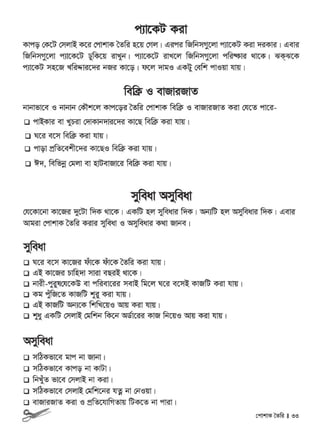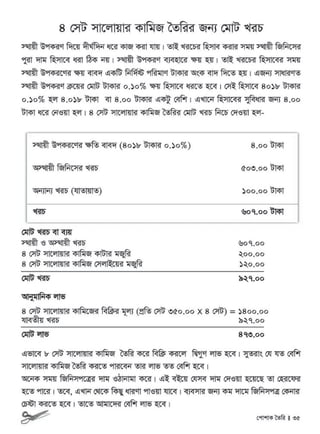1 of 38
Downloaded 20 times






































Ad
Recommended
Bio gas plant-Ó”¼Ó”ŠÓ¦¤Ó¦ŗÓ”ŚÓ¦ŹÓ”»Ó”ŠÓ”Ė Ó”¬Ó¦ŹÓ”▓Ó”ŠÓ”©Ó¦ŹÓ”¤
Bio gas plant-Ó”¼Ó”ŠÓ¦¤Ó¦ŗÓ”ŚÓ¦ŹÓ”»Ó”ŠÓ”Ė Ó”¬Ó¦ŹÓ”▓Ó”ŠÓ”©Ó¦ŹÓ”¤Mustafizur Rahman Palash
╠²
Bio gas plant-Ó”¼Ó”ŠÓ¦¤Ó¦ŗÓ”ŚÓ¦ŹÓ”»Ó”ŠÓ”Ė Ó”¬Ó¦ŹÓ”▓Ó”ŠÓ”©Ó¦ŹÓ”¤Islamic banking and finance in south east asia by angelo m vernandos, its dev...
Islamic banking and finance in south east asia by angelo m vernandos, its dev...Mustafizur Rahman Palash
╠²
The document is a comprehensive study on Islamic banking and finance, detailing its development and future in Southeast Asia. It covers historical contexts, Shari'ah law, commercial law, financial products, and contemporary challenges faced by Islamic banking in the region. The work emphasizes the significance of integrating Islamic principles within modern banking practices and highlights case studies from various Southeast Asian countries.Financial system of bd [www.bconnect24.com]
Financial system of bd [www.bconnect24.com]Mustafizur Rahman Palash
╠²
The document outlines the regulatory and legal framework for Bangladesh's financial system. The key regulators are the Bangladesh Bank and Securities and Exchange Commission (SEC), established through the Bangladesh Bank Ordinance of 1972 and SEC Act of 1993 respectively. The financial system includes banking institutions like commercial banks that are regulated by the Banking Companies Act of 1991, and non-banking financial institutions regulated by the Financial Institutions Act of 1993, including leasing companies, housing finance companies, and investment banks. Capital markets involving stocks, bonds, and funds are also discussed.Statement of affairs
Statement of affairsMustafizur Rahman Palash
╠²
The document provides statements of affairs for Mt Merapi Corp and HBD Corp. A statement of affairs shows a company's assets and how they are pledged, as well as its liabilities in order of priority. For each company, the summary lists assets and liabilities with book values, then calculates the estimated amounts available to unsecured creditors based on estimated current values and amounts pledged to secured creditors. It also calculates the percentage dividend that would be paid to unsecured creditors.The economics of banking by kent mathkewn and john thompson www.bconnect24.com
The economics of banking by kent mathkewn and john thompson www.bconnect24.comMustafizur Rahman Palash
╠²
This chapter discusses major trends that have changed the banking sector in recent decades, including deregulation, financial innovation, globalization, and increased competition. Deregulation has reduced restrictions on banks' pricing and activities. Financial innovation has led to new markets, instruments, and an emphasis on risk management. Globalization means most major banks now operate worldwide. These changes have made the banking industry more competitive. The chapter sets the context for later discussions that will analyze these trends and their effects on bank behavior and performance in more detail.The future of banking
The future of bankingMustafizur Rahman Palash
╠²
This document is a collection of essays on the future of banking edited by Thorsten Beck and published by VoxEU.org. It addresses both immediate solutions to the ongoing financial crisis as well as long-term regulatory reforms. Beck introduces the collection by noting that banks are again at the center of the crisis as sovereign debt problems in Europe threaten bank solvency. He argues that not enough was done after the 2008 crisis to fix underlying problems, and that rather than more bailouts there needs to be a move towards forcing banks to internalize external costs and risks. The collection contains essays by various economists on topics such as resolving the Eurozone crisis, banking regulation reforms, capital requirements, and the role of emerging market banks.E banking management - issues solutions and strategies
E banking management - issues solutions and strategiesMustafizur Rahman Palash
╠²
This document provides an overview of the book "E-Banking Management: Issues, Solutions, and Strategies" which focuses on the human, operational, managerial, and strategic issues related to e-banking. The book contains 8 chapters that cover topics such as the delivery of retail banking services, an overview of e-banking technologies and models, managerial challenges of e-banking, the role of human involvement, problematic issues, and case studies of successful e-banking strategies. The document provides the table of contents to give a high-level view of the coverage and organization of the book.Corporate & investment banking by mckinsey [www.bconnect24.com]
Corporate & investment banking by mckinsey [www.bconnect24.com]Mustafizur Rahman Palash
╠²
The document discusses several challenges and opportunities facing global securities firms. It notes that while last year's results were good, the industry faces evolving businesses that require new strategies. Successful firms will serve both large companies seeking strategic advice and the growing middle market. They will also adapt to changing relationships with large clients, financial sponsors, and hedge funds as private and public boundaries blur. Firms will need new models to serve sponsors and uncover investment opportunities, while also advising companies on private vs. public financing options. Overall the industry faces pressure to develop innovative solutions across client segments.Banking by n. t. somashekar [www.bconnect24.com]
Banking by n. t. somashekar [www.bconnect24.com]Mustafizur Rahman Palash
╠²
This document provides an introduction and preface to a textbook on banking. It discusses the motivation and goals for writing the textbook, which is intended to cover banking syllabi for various degree programs in India. The author acknowledges the contributions of colleagues, friends, and family who provided suggestions and assistance. They also thank the publishing company for bringing out the book in a timely manner. In closing, the author invites feedback from students and teachers to help improve future editions.Nursery booklet- Ó”©Ó”ŠÓ”░Ó¦ŹÓ”ĖÓ”ŠÓ”░Ó¦Ć
Nursery booklet- Ó”©Ó”ŠÓ”░Ó¦ŹÓ”ĖÓ”ŠÓ”░Ó¦ĆMustafizur Rahman Palash
╠²
Nursery booklet- Ó”©Ó”ŠÓ”░Ó¦ŹÓ”ĖÓ”ŠÓ”░Ó¦ĆKagojer bag kham o thonga- Ó”ĢÓ”ŠÓ”ŚÓ”£Ó¦ćÓ”░ Ó”¼Ó¦ŹÓ”»Ó”ŠÓ”Ś, Ó”¢Ó”ŠÓ”« Ó”ō Ó”ĀÓ¦ŗÓ”ÖÓ”Š
Kagojer bag kham o thonga- Ó”ĢÓ”ŠÓ”ŚÓ”£Ó¦ćÓ”░ Ó”¼Ó¦ŹÓ”»Ó”ŠÓ”Ś, Ó”¢Ó”ŠÓ”« Ó”ō Ó”ĀÓ¦ŗÓ”ÖÓ”Š Mustafizur Rahman Palash
╠²
Kagojer bag kham o thonga- Ó”ĢÓ”ŠÓ”ŚÓ”£Ó¦ćÓ”░ Ó”¼Ó¦ŹÓ”»Ó”ŠÓ”Ś, Ó”¢Ó”ŠÓ”« Ó”ō Ó”ĀÓ¦ŗÓ”ÖÓ”ŠMou machi palon- Ó”«Ó¦īÓ”«Ó”ŠÓ”øÓ”┐ Ó”¬Ó”ŠÓ”▓Ó”© Ó”¬Ó””Ó¦ŹÓ”¦Ó”żÓ”┐
Mou machi palon- Ó”«Ó¦īÓ”«Ó”ŠÓ”øÓ”┐ Ó”¬Ó”ŠÓ”▓Ó”© Ó”¬Ó””Ó¦ŹÓ”¦Ó”żÓ”┐Mustafizur Rahman Palash
╠²
Mou machi palon- Ó”«Ó¦īÓ”«Ó”ŠÓ”øÓ”┐ Ó”¬Ó”ŠÓ”▓Ó”© Ó”¬Ó””Ó¦ŹÓ”¦Ó”żÓ”┐Mushrum book- Ó”«Ó”ŠÓ”ČÓ”░Ó¦éÓ”« Ó”ÜÓ”ŠÓ”Ę Ó”¬Ó””Ó¦ŹÓ”¦Ó”żÓ”┐
Mushrum book- Ó”«Ó”ŠÓ”ČÓ”░Ó¦éÓ”« Ó”ÜÓ”ŠÓ”Ę Ó”¬Ó””Ó¦ŹÓ”¦Ó”żÓ”┐Mustafizur Rahman Palash
╠²
Mushrum book- Ó”«Ó”ŠÓ”ČÓ”░Ó¦éÓ”« Ó”ÜÓ”ŠÓ”Ę Ó”¬Ó””Ó¦ŹÓ”¦Ó”żÓ”┐Cycle rickshaw o vhan maramote cycle rickshaw & vhan repairing Mustafizur Rahman Palash
╠²
Le document semble se limiter ├Ā une s├®quence de chiffres allant de 1 ├Ā 36. Il ne contient pas d'informations compl├®mentaires ou contextuelles. Par cons├®quent, le r├®sum├® est tr├©s succinct.Booklet flower gardening-Ó”½Ó¦üÓ”▓Ó¦ćÓ”░ Ó”¼Ó”ŠÓ”ŚÓ”ŠÓ”©
Booklet flower gardening-Ó”½Ó¦üÓ”▓Ó¦ćÓ”░ Ó”¼Ó”ŠÓ”ŚÓ”ŠÓ”©Mustafizur Rahman Palash
╠²
Booklet flower gardening-Ó”½Ó¦üÓ”▓Ó¦ćÓ”░ Ó”¼Ó”ŠÓ”ŚÓ”ŠÓ”©Chanachour book- Ó”ÜÓ”ŠÓ”©Ó”ŠÓ”ÜÓ¦üÓ”░ Ó”żÓ¦łÓ”░Ó”┐
Chanachour book- Ó”ÜÓ”ŠÓ”©Ó”ŠÓ”ÜÓ¦üÓ”░ Ó”żÓ¦łÓ”░Ó”┐Mustafizur Rahman Palash
╠²
Chanachour book- Ó”ÜÓ”ŠÓ”©Ó”ŠÓ”ÜÓ¦üÓ”░ Ó”żÓ¦łÓ”░Ó”┐Block print- Ó”¼Ó¦ŹÓ”▓Ó”Ģ Ó”¬Ó¦ŹÓ”░Ó”┐Ó”©Ó¦ŹÓ”¤
Block print- Ó”¼Ó¦ŹÓ”▓Ó”Ģ Ó”¬Ó¦ŹÓ”░Ó”┐Ó”©Ó¦ŹÓ”¤Mustafizur Rahman Palash
╠²
Block print- Ó”¼Ó¦ŹÓ”▓Ó”Ģ Ó”¬Ó¦ŹÓ”░Ó”┐Ó”©Ó¦ŹÓ”¤More Related Content
More from Mustafizur Rahman Palash (20)
The future of banking
The future of bankingMustafizur Rahman Palash
╠²
This document is a collection of essays on the future of banking edited by Thorsten Beck and published by VoxEU.org. It addresses both immediate solutions to the ongoing financial crisis as well as long-term regulatory reforms. Beck introduces the collection by noting that banks are again at the center of the crisis as sovereign debt problems in Europe threaten bank solvency. He argues that not enough was done after the 2008 crisis to fix underlying problems, and that rather than more bailouts there needs to be a move towards forcing banks to internalize external costs and risks. The collection contains essays by various economists on topics such as resolving the Eurozone crisis, banking regulation reforms, capital requirements, and the role of emerging market banks.E banking management - issues solutions and strategies
E banking management - issues solutions and strategiesMustafizur Rahman Palash
╠²
This document provides an overview of the book "E-Banking Management: Issues, Solutions, and Strategies" which focuses on the human, operational, managerial, and strategic issues related to e-banking. The book contains 8 chapters that cover topics such as the delivery of retail banking services, an overview of e-banking technologies and models, managerial challenges of e-banking, the role of human involvement, problematic issues, and case studies of successful e-banking strategies. The document provides the table of contents to give a high-level view of the coverage and organization of the book.Corporate & investment banking by mckinsey [www.bconnect24.com]
Corporate & investment banking by mckinsey [www.bconnect24.com]Mustafizur Rahman Palash
╠²
The document discusses several challenges and opportunities facing global securities firms. It notes that while last year's results were good, the industry faces evolving businesses that require new strategies. Successful firms will serve both large companies seeking strategic advice and the growing middle market. They will also adapt to changing relationships with large clients, financial sponsors, and hedge funds as private and public boundaries blur. Firms will need new models to serve sponsors and uncover investment opportunities, while also advising companies on private vs. public financing options. Overall the industry faces pressure to develop innovative solutions across client segments.Banking by n. t. somashekar [www.bconnect24.com]
Banking by n. t. somashekar [www.bconnect24.com]Mustafizur Rahman Palash
╠²
This document provides an introduction and preface to a textbook on banking. It discusses the motivation and goals for writing the textbook, which is intended to cover banking syllabi for various degree programs in India. The author acknowledges the contributions of colleagues, friends, and family who provided suggestions and assistance. They also thank the publishing company for bringing out the book in a timely manner. In closing, the author invites feedback from students and teachers to help improve future editions.Nursery booklet- Ó”©Ó”ŠÓ”░Ó¦ŹÓ”ĖÓ”ŠÓ”░Ó¦Ć
Nursery booklet- Ó”©Ó”ŠÓ”░Ó¦ŹÓ”ĖÓ”ŠÓ”░Ó¦ĆMustafizur Rahman Palash
╠²
Nursery booklet- Ó”©Ó”ŠÓ”░Ó¦ŹÓ”ĖÓ”ŠÓ”░Ó¦ĆKagojer bag kham o thonga- Ó”ĢÓ”ŠÓ”ŚÓ”£Ó¦ćÓ”░ Ó”¼Ó¦ŹÓ”»Ó”ŠÓ”Ś, Ó”¢Ó”ŠÓ”« Ó”ō Ó”ĀÓ¦ŗÓ”ÖÓ”Š
Kagojer bag kham o thonga- Ó”ĢÓ”ŠÓ”ŚÓ”£Ó¦ćÓ”░ Ó”¼Ó¦ŹÓ”»Ó”ŠÓ”Ś, Ó”¢Ó”ŠÓ”« Ó”ō Ó”ĀÓ¦ŗÓ”ÖÓ”Š Mustafizur Rahman Palash
╠²
Kagojer bag kham o thonga- Ó”ĢÓ”ŠÓ”ŚÓ”£Ó¦ćÓ”░ Ó”¼Ó¦ŹÓ”»Ó”ŠÓ”Ś, Ó”¢Ó”ŠÓ”« Ó”ō Ó”ĀÓ¦ŗÓ”ÖÓ”ŠMou machi palon- Ó”«Ó¦īÓ”«Ó”ŠÓ”øÓ”┐ Ó”¬Ó”ŠÓ”▓Ó”© Ó”¬Ó””Ó¦ŹÓ”¦Ó”żÓ”┐
Mou machi palon- Ó”«Ó¦īÓ”«Ó”ŠÓ”øÓ”┐ Ó”¬Ó”ŠÓ”▓Ó”© Ó”¬Ó””Ó¦ŹÓ”¦Ó”żÓ”┐Mustafizur Rahman Palash
╠²
Mou machi palon- Ó”«Ó¦īÓ”«Ó”ŠÓ”øÓ”┐ Ó”¬Ó”ŠÓ”▓Ó”© Ó”¬Ó””Ó¦ŹÓ”¦Ó”żÓ”┐Mushrum book- Ó”«Ó”ŠÓ”ČÓ”░Ó¦éÓ”« Ó”ÜÓ”ŠÓ”Ę Ó”¬Ó””Ó¦ŹÓ”¦Ó”żÓ”┐
Mushrum book- Ó”«Ó”ŠÓ”ČÓ”░Ó¦éÓ”« Ó”ÜÓ”ŠÓ”Ę Ó”¬Ó””Ó¦ŹÓ”¦Ó”żÓ”┐Mustafizur Rahman Palash
╠²
Mushrum book- Ó”«Ó”ŠÓ”ČÓ”░Ó¦éÓ”« Ó”ÜÓ”ŠÓ”Ę Ó”¬Ó””Ó¦ŹÓ”¦Ó”żÓ”┐Cycle rickshaw o vhan maramote cycle rickshaw & vhan repairing Mustafizur Rahman Palash
╠²
Le document semble se limiter ├Ā une s├®quence de chiffres allant de 1 ├Ā 36. Il ne contient pas d'informations compl├®mentaires ou contextuelles. Par cons├®quent, le r├®sum├® est tr├©s succinct.Booklet flower gardening-Ó”½Ó¦üÓ”▓Ó¦ćÓ”░ Ó”¼Ó”ŠÓ”ŚÓ”ŠÓ”©
Booklet flower gardening-Ó”½Ó¦üÓ”▓Ó¦ćÓ”░ Ó”¼Ó”ŠÓ”ŚÓ”ŠÓ”©Mustafizur Rahman Palash
╠²
Booklet flower gardening-Ó”½Ó¦üÓ”▓Ó¦ćÓ”░ Ó”¼Ó”ŠÓ”ŚÓ”ŠÓ”©Chanachour book- Ó”ÜÓ”ŠÓ”©Ó”ŠÓ”ÜÓ¦üÓ”░ Ó”żÓ¦łÓ”░Ó”┐
Chanachour book- Ó”ÜÓ”ŠÓ”©Ó”ŠÓ”ÜÓ¦üÓ”░ Ó”żÓ¦łÓ”░Ó”┐Mustafizur Rahman Palash
╠²
Chanachour book- Ó”ÜÓ”ŠÓ”©Ó”ŠÓ”ÜÓ¦üÓ”░ Ó”żÓ¦łÓ”░Ó”┐Block print- Ó”¼Ó¦ŹÓ”▓Ó”Ģ Ó”¬Ó¦ŹÓ”░Ó”┐Ó”©Ó¦ŹÓ”¤
Block print- Ó”¼Ó¦ŹÓ”▓Ó”Ģ Ó”¬Ó¦ŹÓ”░Ó”┐Ó”©Ó¦ŹÓ”¤Mustafizur Rahman Palash
╠²
Block print- Ó”¼Ó¦ŹÓ”▓Ó”Ģ Ó”¬Ó¦ŹÓ”░Ó”┐Ó”©Ó¦ŹÓ”¤Kagojer bag kham o thonga- Ó”ĢÓ”ŠÓ”ŚÓ”£Ó¦ćÓ”░ Ó”¼Ó¦ŹÓ”»Ó”ŠÓ”Ś, Ó”¢Ó”ŠÓ”« Ó”ō Ó”ĀÓ¦ŗÓ”ÖÓ”Š
Kagojer bag kham o thonga- Ó”ĢÓ”ŠÓ”ŚÓ”£Ó¦ćÓ”░ Ó”¼Ó¦ŹÓ”»Ó”ŠÓ”Ś, Ó”¢Ó”ŠÓ”« Ó”ō Ó”ĀÓ¦ŗÓ”ÖÓ”Š Mustafizur Rahman Palash
╠²
